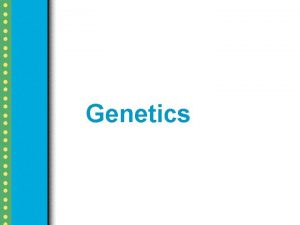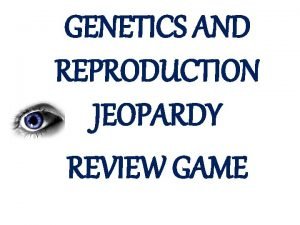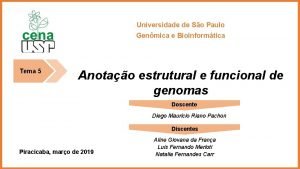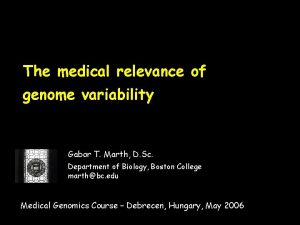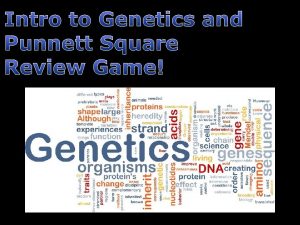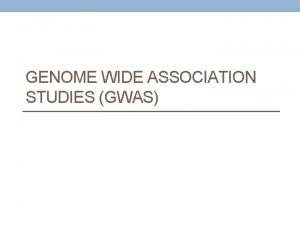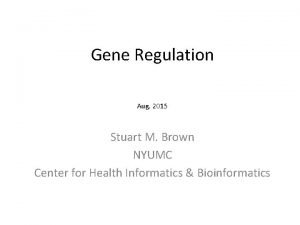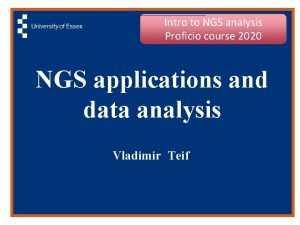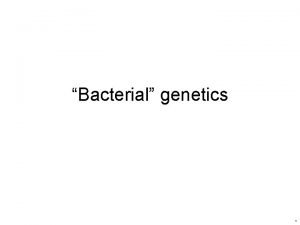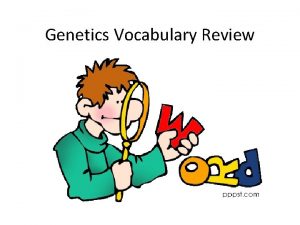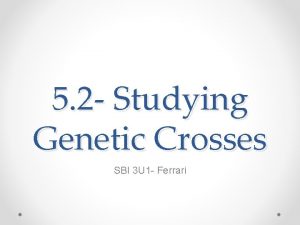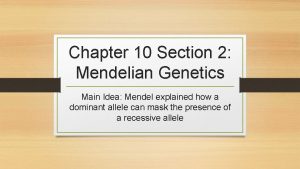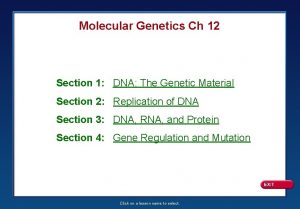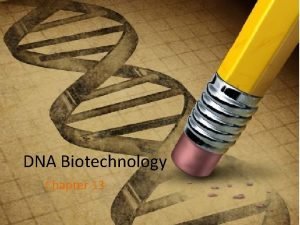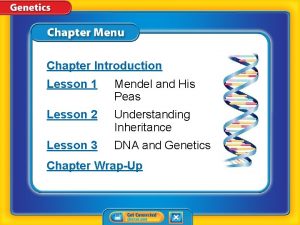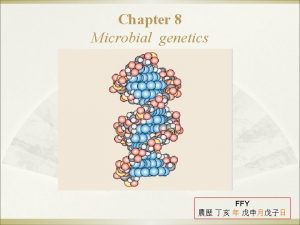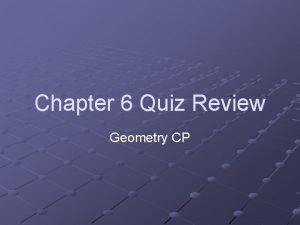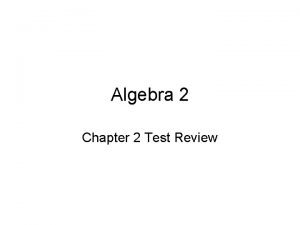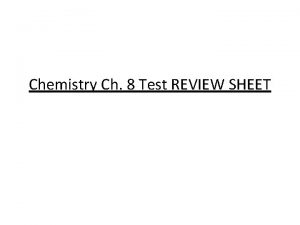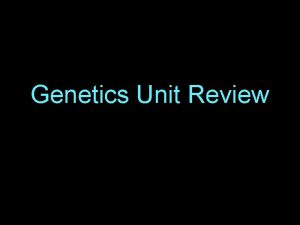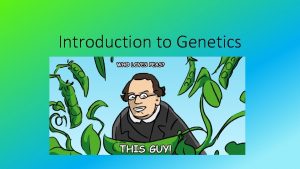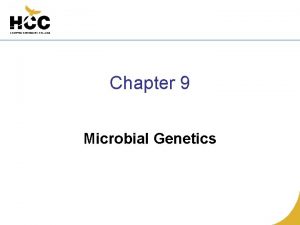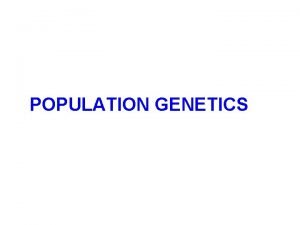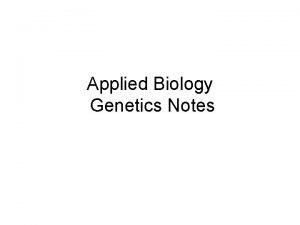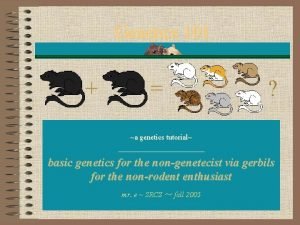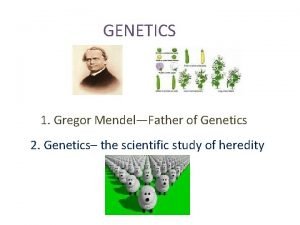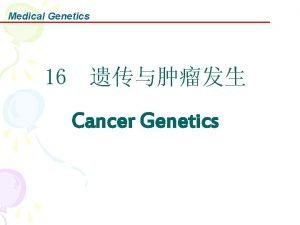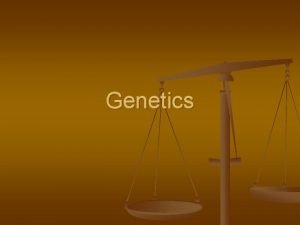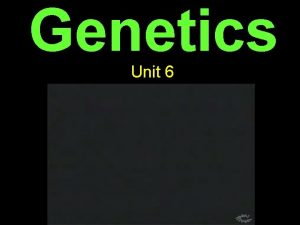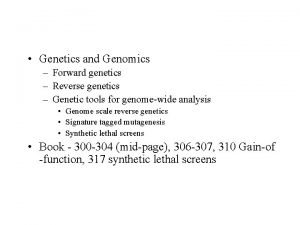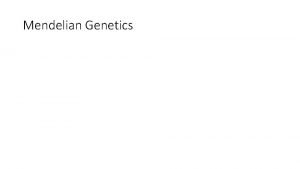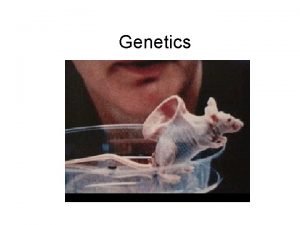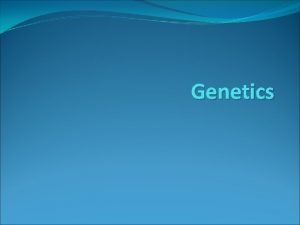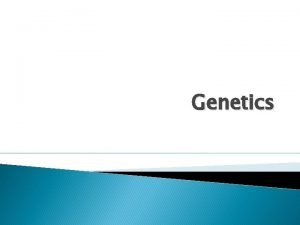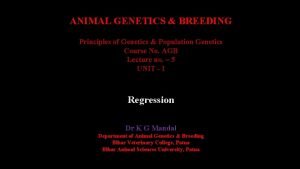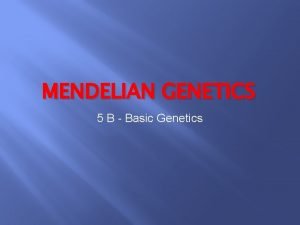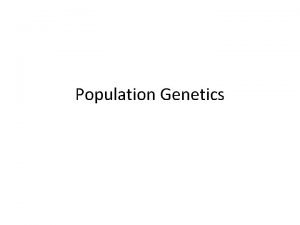Genetics Test Review Chapter 11 Match the Scientists











































































- Slides: 75

Genetics Test Review Chapter 11

Match the Scientists • 1. Mendel • 2. Morgan • 3. Sturtevant • A. recombination helps make map B. alleles segregate C. some genes linked

Match the Scientists • 1. Mendel B. alleles segregate • 2. Morgan C. genes linked 3. Sturtevant • A. recombination helps make map

4. What is fertilization? • Process of sexual reproduction • Joining egg + sperm • Joining egg and pollen

What is true-breeding and hybrid? • 5. True-breeding = E. offspring are identical to parents • 6. Hybrid = D. offspring are of parents of different traits

7. Genes are____: • F. the location on a chromosome for a trait

PUNNETT PRACTICE • p. 3 Dihybrid Cross • What are the parental genotypes? • Heterozygous running, heterozygous black mouse • Homozygous running, homozygous black mouse

PUNNETT PRACTICE • p. 3 Dihybrid Cross • What are the parental genotypes? • Heterozygous running, heterozygous black mouse Rr. Bb • Homozygous running, homozygous black mouse RRBB

PUNNETT PRACTICE • Dihybrid Cross • How many boxes to you need for a dihybrid cross? • ANSWER: • 16

PUNNETT PRACTICE • Show you would place the parental alleles on each side of the Punnett Squares:

RB RB RB Rb r. B rb

NOW FILL IN THE BOXES AND • WHAT IS THE PHENOTYPIC RATIO?

100% running black RB RB RB Rb r. B rb RRBB RRBb Rr. BB Rr. Bb

8. Gametes are: • • A. body cells B. sex cells C. somatic cells D. skin cells • ANSWER: sex cells B

9. The likelihood that a particular event will occur is: • • A. hybrid B. offspring C. probability D. recombination • ANSWER: C probability

10. The wild type is… • A. dominant trait • B. recessive trait • C. most common trait • ANSWER: C

11. homologous • D. male + corresponding female set of chromosomes

GO TO PUNNETT PRACTICE • On your dry erase board. • Do #4 on page 2. • Cross two plants that are heterozygous for green pods.

#4 Answer Genotypic ratio: GG: Gg: gg 1: 2: 1 Phenotypic ratio: Green: yellow 3: 1 G g G GG Gg gg

12. Haploid and 13. Diploid • 13. C. one set of chromosomes N in humans 23 14. B. two sets of homologous chromosomes 2 N in humans 46

14. What is a tetrad? • A. 4 homologous chromosomes

MULTIPLE ALLELE TRAITS IN CHICKENS • Question #1: On the cross pictured, what must be the genotypes of the two parents for the outcome to always be a buttercup offspring? • ANSWER: • rr. PP X RRpp

Did you set it up right? RP RP Rp r. P rp

9: 3: 3: 1 RP Rp r. P rp RRPP RRPp Rr. PP Rr. Pp RRpp Rr. Pp Rrpp Rr. PP Rr. Pp rr. PP rr. Pp Rrpp rr. Pp rrpp

15. Crossing-over • F. homologous chromosomes exchange segments

16. What is a chiasma? • • • A. when 4 chromosomes come together B. when a cell divides into 4 cells C. when a cell splits D. making poopie E. is the point of crossing over of the two inner homologous chromosomes • ANSWER: E

17. Contrast Mitosis and Meiosis • Mitosis: • • • starts with 2 N parent Daughter cells are 2 N Daughter cells identical Makes somatic cells Ends with 2 cells 1 division

17. Contrast Mitosis and Meiosis • Meiosis: • • • starts with 2 N parent Daughter cells are N Daughter cells different Makes sex cells Ends with 4 cells 2 divisions

18. If you had a tall plant, how can you tell if it is TT or Tt? • Cross it with tt • (a test cross) T t t T T t t t

18. If you had a tall plant, how can you tell if it is TT or Tt? T • Cross it with tt t T Tt Tt tt

19. Spongebob Ss. Yy marries and mates Spongebetty ss. Yy Y=yellow y=blue S=square s=round

19. Spongebob Ss. Yy marries and mates Spongebetty ss. Yy Y=yellow y=blue S=square s=round

19. Ss. Yy X ss. Yy SY Sy s. Y sy Ss. YY Ss. Yy ss. YY ss. Yy sy Ss. Yy Ssyy ss. Yy ssyy Ss. YY Ss. Yy ss. YY ss. Yy Ssyy ss. Yy ssyy s. Y sy

19. Ss. Yy X ss. Yy SY Sy s. Y sy Ss. YY Ss. Yy ss. YY ss. Yy sy Ss. Yy Ssyy ss. Yy ssyy Ss. YY Ss. Yy ss. YY ss. Yy Ssyy ss. Yy ssyy s. Y sy

6 square yellow 2 square blue SY Sy 6 round yellow 2 round blue s. Y sy Ss. YY Ss. Yy ss. YY ss. Yy sy Ss. Yy Ssyy ss. Yy ssyy Ss. YY Ss. Yy ss. YY ss. Yy Ssyy ss. Yy ssyy s. Y sy

20. Flower Parts

EXTRA: Male Flower Parts? • Stamen pistil stigma anther • ANSWER: stamen anther

21. Hetero or Homo zygous • _____HH _____hh _____Hh • ANSWER: • Homozygous Heterozygous • HH hh Hh

EXTRA: Recessive? • T t H h • ANSWER: t h

EXTRA: Dominant? • T t H h • ANSWER: T H

CHECK YOUR SKILLS: Go to Punnett Practice #7 • Genotypic Ratio? • Phenotypic Ratio?

Nn x nn • N n n Nn n nn Genotypic: Nn: nn 2 : 2 Nn nn Phenotypic Smooth; const. 2 : 2

CHECK YOUR SKILLS: Bb. Ff x bbff • How many boxes do you need? 16 • How do you separate each parent? BF Bf b. F bf • bf bf

BF bf Bf b. F bf Bb. Ff Bbff bb. Ff bbff Bb. Ff bf Bbff bb. Ff bbff Bb. Ff Bbff bb. Ff bbff bf bf

• Genotypic Ratio • Bb. Ff : Bbff : bb. Ff : bbff • 4 4 • Phenotypic Ratio • Black fat : black thin : white fat : white thin • 4 4

CHECK YOUR SKILLS: RR x RW incomplete dominance • R R W R

CHECK YOUR ANSWER: RR x RW incomplete dominance • R R W RR RW R RR RW Genotypic RR : RW 2 2 Phenotypic Red : Pink 2 2

#22 • Black rooster and white chicken form black and white spotted chicks • ANSWER: codominance

#23 • The color of the skin is determined by six different locations on genes • ANSWER: polygenic trait

#24 • A red flower is crossed with a white flower to make pink offspring. • ANSWER: incomplete dominance

#25 • TT x WW = TW offspring • ANSWER: codominance

#26 • Eye color alternatives include blue, brown, green, black • ANSWER: multiple alleles

#27 • A black rabbit crossed with a white rabbit produced a gray rabbit • ANSWER: incomplete dominance

#29 • ANSWER: The higher the crossover frequency, the farther apart are the genes.

#28 • The greater the number of recombination frequencies (crossovers), then the _____ the genes are to each other. • ANSWER: farther apart

#29 • Red, hair freckles, and fair skin seem to be inherited together. They must be on _____ genes. • ANSWER: linked

#30 • The location on a chromosome is referred to as the: • ANSWER: locus gene

Back of chicken worksheet: • Do questions #1 and #2

• Incomplete dominance = the offspring show trait in-between the two dominant traits (like black and white have gray offspring) • Codominance = both dominant traits will appear like black and white will have spotted black-white offspring

• Genotype for black chickens BB • Genotype for white chickens WW • Genotype for erminette BW

#31 • What is the difference between a trait and an allele? • TRAIT: general description EX; eye color, height ALLELE: alternative choices EX: blue and green, and tall-short

A-B = 29% B-C=11% B-D=4% A-D = 21 % ADD: A-C =18% C-D = 3% What is the order of these genes? • ANSWER: A C D B

32. Names of the phases in meiosis:

32. Names of the phases in meiosis: Anaphase I Metaphase I Prophase II Anaphase II Metaphase II Telophase II Prophase I Telophase I

#33 Structures of Prophase I

Go to Back and do “Polygenic Inheritance” Worksheet • Human Skin Shades • Mulatto denotes a person with one white parent and one black parent, or more broadly, a person of mixed black and white ancestry. May also include Native American and other backgrounds.

KNOW YOUR MATCHING • Numbers of descriptions of offspring • phenotypic ratio • Numbers of letters of offspring , TT, Tt, tt • genotypic ratio • Trait that is expressed even if other trait is present • dominant

32. MATCHING (cont. ) • Trait that is only expressed if the dominant trait is not present • recessive • Alternative choices of a trait • alleles

32. MATCHING (cont) • General description of a gene • trait • Plant’s pollen fertilizes the same plant • self-pollination • Plant’s pollen fertilizes a different plant • cross-pollination

Can You Identify? locus

Compare egg and sperm: • Egg forms one large egg and three smaller polar bodies • Sperm form all the same size and shape


What is the purpose of the Punnett Square? • • A. show the exact offspring B. show only dominant offspring C. predict the probability from a cross D. predict who will win the sperm lotto • ANSWER: C

Independent Assortment and Crossing Over • Independent Assortment randomly segregates the alleles. • Crossing-over breaks and reattaches chromosomes to make new gene arrangements. • BOTH INCREASE DIVERSITY

ESSAYS? • • Punnett Squares Monohybrid Cross Codominant or Incomplete Dominant Dihybrid Cross Be able to write a genotypic and phenotypic ratio.
 What does the notation tt mean to geneticists?
What does the notation tt mean to geneticists? Genetics jeopardy review game
Genetics jeopardy review game Nature review genetics
Nature review genetics Nature review genetics
Nature review genetics Punnett square review games
Punnett square review games Nature review genetics
Nature review genetics Nature review genetics
Nature review genetics Nature review genetics
Nature review genetics Nature review genetics
Nature review genetics Genetic vocabulary review
Genetic vocabulary review Genetics vocabulary review
Genetics vocabulary review Chapter review motion part a vocabulary review answer key
Chapter review motion part a vocabulary review answer key Sbi3u genetics test
Sbi3u genetics test Unit 1 test algebra 2 answers
Unit 1 test algebra 2 answers Mendelian genetics
Mendelian genetics Chapter 7 extending mendelian genetics answer key
Chapter 7 extending mendelian genetics answer key Chapter 22 genetics and genetically linked diseases
Chapter 22 genetics and genetically linked diseases Chapter 12 section 1 molecular genetics answer key
Chapter 12 section 1 molecular genetics answer key Chapter 12 section 1 dna the genetic material
Chapter 12 section 1 dna the genetic material Chapter 10 section 2 mendelian genetics
Chapter 10 section 2 mendelian genetics Chapter 7 vocabulary practice extending mendelian genetics
Chapter 7 vocabulary practice extending mendelian genetics Chapter 10 sexual reproduction and genetics
Chapter 10 sexual reproduction and genetics Molecular genetics chapter 12
Molecular genetics chapter 12 X linked recessive punnett square
X linked recessive punnett square Chapter 7 extending mendelian genetics vocabulary practice
Chapter 7 extending mendelian genetics vocabulary practice Genetics and biotechnology chapter 13
Genetics and biotechnology chapter 13 Solid
Solid Chapter 8 microbial genetics
Chapter 8 microbial genetics Chapter 17 lesson 2 heredity and genetics
Chapter 17 lesson 2 heredity and genetics Chapter 6 quiz 2 geometry answers
Chapter 6 quiz 2 geometry answers Chapter 2 test review algebra 1
Chapter 2 test review algebra 1 Chapter 8 test review chemistry
Chapter 8 test review chemistry Palo alto panorama demo
Palo alto panorama demo Hát kết hợp bộ gõ cơ thể
Hát kết hợp bộ gõ cơ thể Slidetodoc
Slidetodoc Bổ thể
Bổ thể Tỉ lệ cơ thể trẻ em
Tỉ lệ cơ thể trẻ em Chó sói
Chó sói Chụp phim tư thế worms-breton
Chụp phim tư thế worms-breton Chúa yêu trần thế
Chúa yêu trần thế Các môn thể thao bắt đầu bằng tiếng bóng
Các môn thể thao bắt đầu bằng tiếng bóng Thế nào là hệ số cao nhất
Thế nào là hệ số cao nhất Các châu lục và đại dương trên thế giới
Các châu lục và đại dương trên thế giới Cong thức tính động năng
Cong thức tính động năng Trời xanh đây là của chúng ta thể thơ
Trời xanh đây là của chúng ta thể thơ Mật thư tọa độ 5x5
Mật thư tọa độ 5x5 Làm thế nào để 102-1=99
Làm thế nào để 102-1=99 Phản ứng thế ankan
Phản ứng thế ankan Các châu lục và đại dương trên thế giới
Các châu lục và đại dương trên thế giới Thể thơ truyền thống
Thể thơ truyền thống Quá trình desamine hóa có thể tạo ra
Quá trình desamine hóa có thể tạo ra Một số thể thơ truyền thống
Một số thể thơ truyền thống Cái miệng nó xinh thế
Cái miệng nó xinh thế Vẽ hình chiếu vuông góc của vật thể sau
Vẽ hình chiếu vuông góc của vật thể sau Biện pháp chống mỏi cơ
Biện pháp chống mỏi cơ đặc điểm cơ thể của người tối cổ
đặc điểm cơ thể của người tối cổ Ví dụ giọng cùng tên
Ví dụ giọng cùng tên Vẽ hình chiếu đứng bằng cạnh của vật thể
Vẽ hình chiếu đứng bằng cạnh của vật thể Tia chieu sa te
Tia chieu sa te Thẻ vin
Thẻ vin đại từ thay thế
đại từ thay thế điện thế nghỉ
điện thế nghỉ Tư thế ngồi viết
Tư thế ngồi viết Diễn thế sinh thái là
Diễn thế sinh thái là Dạng đột biến một nhiễm là
Dạng đột biến một nhiễm là Số nguyên tố là gì
Số nguyên tố là gì Tư thế ngồi viết
Tư thế ngồi viết Lời thề hippocrates
Lời thề hippocrates Thiếu nhi thế giới liên hoan
Thiếu nhi thế giới liên hoan ưu thế lai là gì
ưu thế lai là gì Khi nào hổ con có thể sống độc lập
Khi nào hổ con có thể sống độc lập Khi nào hổ con có thể sống độc lập
Khi nào hổ con có thể sống độc lập Sơ đồ cơ thể người
Sơ đồ cơ thể người Từ ngữ thể hiện lòng nhân hậu
Từ ngữ thể hiện lòng nhân hậu Thế nào là mạng điện lắp đặt kiểu nổi
Thế nào là mạng điện lắp đặt kiểu nổi Chapter 6 career readiness
Chapter 6 career readiness
